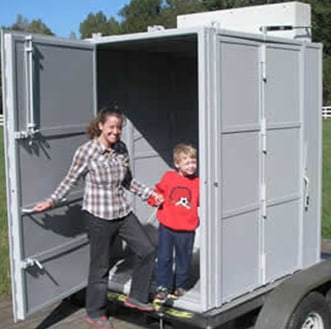My last blog discussed the “piecemeal approach” to active shooter security and physical security in general. During discussions at trade shows, conventions and site visits, there has been a pervasive general approach to the development of active shooter protection measures. Again, either planning for the last active shooter event or hearing/learning that one organization is adopting this or that measure or procedure, especially if low cost and then also adopting that measure. Recurring theme: This Something is better than Nothing. I cannot disagree with that statement depending on what “Something” is. However, does it really provide any measurable increase in protection? Remember the goal in all the “active shooter preparations” is to have everyone survive.
What is the primary ballistic protection every student wears every day to school? Easy, a shirt of cloth type material. Clothing is not designed to provide ballistic protection. If wearing a backpack at the time of a shooting, there may be a little more protection but not enough. The shirt however can be ripped off if need be to make an emergency bandage. No cost to the school, but “Something is better than Nothing!”
I know of a charter school that just installed 2-inch steel chain link fence posts in front of the school as a bollard barrier. They were mounted in concrete, probably concreted in place, do not know if the center was filled with concrete but I will give them the benefit of the doubt. Fairly cheap effort, but what is the protection increase? Now, the universal bollard standard is an 8-inch in diameter, ¼-inch thick steel post, concreted 4 feet in the ground and filled with concrete, resulting in protection from a 15,000 lb truck at 45 miles per hour. A regular car or light pick-up truck can drive right through these chain link fence posts. But, “Something is better than Nothing!” If one is going to spend funding, take time and give the feeling of adequate protection, one should do it correctly.
Another favorite is the preposition of river rocks or canned food, both to be used to throw at an intruder as an effort to “empower the students”. So, this is the “Fight” portion of the federal recommendations but probably not really meant for school age students. In order for it to be a serious effort, all students and staff should be given training in throwing and targeting a person and maybe some will if an event occurs that requires this response. Range time versus recess. Without practice, only a few may “fight back”; with practice, maybe a few more but all will not. Nevertheless, what we have here as a bright idea cook-off from non-security administrative types who think they are smarter than physical security professionals. Does this capability Deter, or Delay or Protect? Maybe a little more deterrence if the schools were to post signs warning intruders of rock or canned food armed students and staff. Again, not much costs to school system, but “Something is better than Nothing!”.
The last subject is the increased protection of the entry point or doors. There are a wide variety of approaches which almost all of them are designed to increase delay. That part is good, only if the next layer is adequate protection. If door is breached, shooter gets into the room and still cannot shoot students because they are protected by a physical barrier, then the door delay is probably worthwhile. Another recurring misnomer is no active shooter has attempted or overcome a locked door so the locked door is the answer. The Sandy Hook shooter shot through two panes of glass beside the locked entry doors, slowing him down about 3 to 5 seconds. One must know (and very surprising how many do not know) that all the firearms used by active shooters will shoot right through almost all school doors. And, we have had a student shot by active shooter by simply shooting through the door (especially made easy by the window in the door or beside the door). Also, the door, its frame, hinges and locks can all be attacked by firearms and overcome very quickly. To have the door as a barrier, the door itself should be up-armored (to a Level 8 as identified by FEMA), reinforced door hinges and locks and the entire door frame reinforced. If not this level of protection (can get expensive), the door is a delay barrier and should be treated as such. But, remember, in the minds of some authorities, any effort, even a rubber door stop, “is better than Nothing!”, so actual planning stops here.
The last really economic measures by schools to the active shooter protection will be “Faith, Hope, Luck and Prayers”. Very Economical and are also “Better than Nothing!”.




